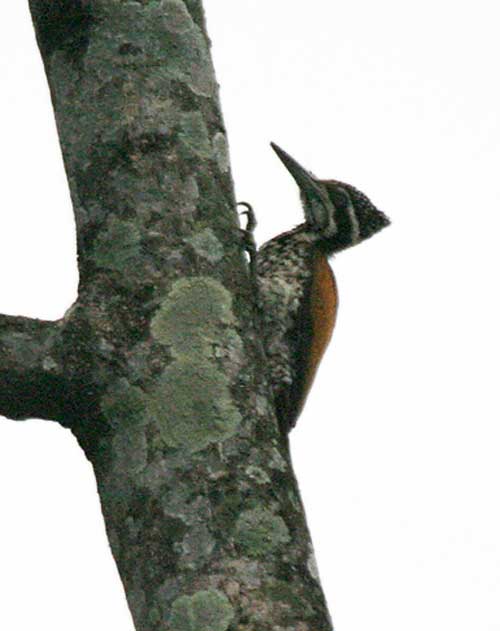
Dinopium shorii(*)
Superregnum: Eukaryota
Cladus: Unikonta
Cladus: Opisthokonta
Cladus: Holozoa
Regnum: Animalia
Subregnum: Eumetazoa
Cladus: Bilateria
Cladus: Nephrozoa
Superphylum: Deuterostomia
Phylum: Chordata
Subphylum: Vertebrata
Infraphylum: Gnathostomata
Megaclassis: Osteichthyes
Cladus: Sarcopterygii
Cladus: Rhipidistia
Cladus: Tetrapodomorpha
Cladus: Eotetrapodiformes
Cladus: Elpistostegalia
Superclassis: Tetrapoda
Cladus: Reptiliomorpha
Cladus: Amniota
Classis: Reptilia
Cladus: Eureptilia
Cladus: Romeriida
Subclassis: Diapsida
Cladus: Sauria
Infraclassis: Archosauromorpha
Cladus: Crurotarsi
Divisio: Archosauria
Cladus: Avemetatarsalia
Cladus: Ornithodira
Subtaxon: Dinosauromorpha
Cladus: Dinosauriformes
Cladus: Dracohors
Cladus: Dinosauria
Ordo: Saurischia
Cladus: Eusaurischia
Subordo: Theropoda
Cladus: Neotheropoda
Cladus: Averostra
Cladus: Tetanurae
Cladus: Avetheropoda
Cladus: Coelurosauria
Cladus: Tyrannoraptora
Cladus: Maniraptoromorpha
Cladus: Maniraptoriformes
Cladus: Maniraptora
Cladus: Pennaraptora
Cladus: Paraves
Cladus: Eumaniraptora
Cladus: Avialae
Infraclassis: Aves
Cladus: Euavialae
Cladus: Avebrevicauda
Cladus: Pygostylia
Cladus: Ornithothoraces
Cladus: Ornithuromorpha
Cladus: Carinatae
Parvclassis: Neornithes
Cohors: Neognathae
Cladus: Neoaves
Ordo: Piciformes
Familia: Picidae
Subfamilia: Picinae
Genus: Dinopium
Species: Dinopium shorii
Subspecies D. s. anguste - D. s. shorii
Name
Dinopium shorii (Vigors, 1832)
References
Proceedings of the Zoological Society of London Pt1 no.14 p. 175
Vernacular names
বাংলা: হিমালয়ী কাঠঠোকরা
English: Himalayan Flameback
español: Pito de Shore
suomi: Isotulitöyhtö
नेपाली: तीनऔंले लाहाँचे
The Himalayan flameback (Dinopium shorii), also known as the Himalayan goldenback, is a species of bird in the family Picidae. At the moment very little is known of this species and more fieldwork is required. The Himalayan flameback is not threatened but it is suspected that deforestation could severely affect the species population.[2]
Description
The Himalayan flameback is very similar in appearance to the Greater Goldenback (Chrysocolaptes lucidus), but is not at all closely related. The primary difference is its smaller size and bill.[3] The Himalayan flameback can be identified by: their black hind neck, the brownish centre on their throat, that can go down the breast on some and is bordered by an irregular black spotting. They also have an indistinct divided moustachial stripe, the centre of which is brownish and sometimes reddish in males. The Himalayan flameback also has ether reddish or brown eye and three toes. The breast of the Himalayan flameback is irregularly streaked with black but on occasion completely white. Their wings are coppery brown to red in colour.[2][3] Lastly the males have a yellowish-red forehead that becomes more red on the crest. In contrast, the female's crest is entirely black streaked with white. In both sexes the crest is bordered by white and black bands on either side of their head.[2][3]
Taxonomy
Part of the family Picidae and the genus Dinopium which consists of woodpeckers with only three toes,[4] the Himalayan flameback forms a super species with the Common flameback. There are also two recognized sub-species within Himalayan flameback, D.s. shorii and D.s. anguste.[2] The sister species of the Himalayan flameback are Meiglyptes tristis and Celeus brachyurus.[5]
Distribution and habitat
Himalayan flameback at Jayanti in Buxa Tiger Reserve in Jalpaiguri district of West Bengal, India
Himalayan Flamebacks are commonly found in the Indian subcontinent, primarily in the lower-to-middle altitudes of the Himalayan sal forest region.[6][7][8][9][10] Its range spans across Bangladesh, Bhutan, India, Myanmar, and Nepal,[1] where they are year-round residents.[2][10] A disjunct population also occurs in south-eastern Ghats.[11] The Himalayan flameback's habitat mainly compromises of mature tropical/subtropical deciduous forests as well as semi-evergreen forests. They prefer lowland Ficus and Bombax forest.[2][6][7][8]
Behaviour
Vocalization
The Himalayan flameback's call is a series of rapidly repeated klak-klak-klak-klak-klak. The call is slower and softer than the Greater Goldenback.[2][3]
Diet
The diet of Himalayan flamebacks is poorly known. They manly flock and feed together with other birds such as the Greater Goldenback.[2] It is assumed that their primary prey is arthropod insects the same as many other woodpecker species.[6]
Reproduction
Very little know of their breeding habits. What is known is that they breed from March to May and nest in excavated holes in trees. Their clutch size is 2–3 eggs.[2]
References
BirdLife International (2016). "Dinopium shorii". IUCN Red List of Threatened Species. 2016: e.T22681496A92909225. doi:10.2305/IUCN.UK.2016-3.RLTS.T22681496A92909225.en. Retrieved 13 November 2021.
Winkler, Hans, Christie, David A. 2002. "Family Picidae (Woodpeckers)" in del Hoyo, J.; Elliot, A. & Sargatal, J. editors. Handbook of the Birds of the world. Volume 7: Jacamars to Woodpeckers. Lynx Edicions: Barcelona. p. 296-555.
Grimmett, Richard, Inskipp, Carol, Inskipp, Tim, Byers, Clive. 1999. Birds of India, Pakistan, Nepal, Bangladesh, Bhutan, Sri Lanka, and the Maldives. Princeton University Press: Princeton, N.J.
Delacour J. 1951. The Significance of the Number of Toes in Some Woodpeckers and Kingfishers. The Auk. 68 (1): 49-51.
Benz BW, Robbins MB, Peterson AT. 2006. Evolutionary history of woodpeckers and allies (Aves: Picidae): Placing key taxa on the phylogenetic tree. Molecular Phylogenetics and Evolution. 40 (1): 389–399.
Kumar R, Singh P. 2010. Determining woodpecker diversity in the sub-Himalayan forests of northern India using call playbacks. Journal of Field Ornithology. 81 (2): 215-222.
Kumar R, Shahabuddin G, Kumar A. 2014. Habitat determinants of woodpecker abundance and species richness in sub-Himalayan dipterocarp forests of north-west India. Acta Ornithologica. 49 (2): 243-256.
Kumar R, Shahabuddin G, Kumar A. 2011. How good are managed forests at conserving native woodpecker communities? A study in sub-Himalayan dipterocarp forests of northwest India. Biological Conservation. 144 (6): 1876–1884.
Joshi KK, Bhatt D. 2011. Birds Of Three Different Forest (Sal, Pine And Oak) Habitats In Nainital District (Western Himalaya) Of Uttarakhand, India. Nature and Science. 9 (7): 114-121.
Choudhury A. 2001. Some bird records from Nagaland, north-east India. Forktail. 17 (1): 91-103
Abdulali, Humayun; Hussain,SA (1973). "On the occurrence of Goldenbacked Threetoed Woodpecker [Dinopium shorii (Vigors)] south of the Himalayan Range". J. Bombay Nat. Hist. Soc. 70 (1): 200–201.
Retrieved from "http://en.wikipedia.org/"
All text is available under the terms of the GNU Free Documentation License

